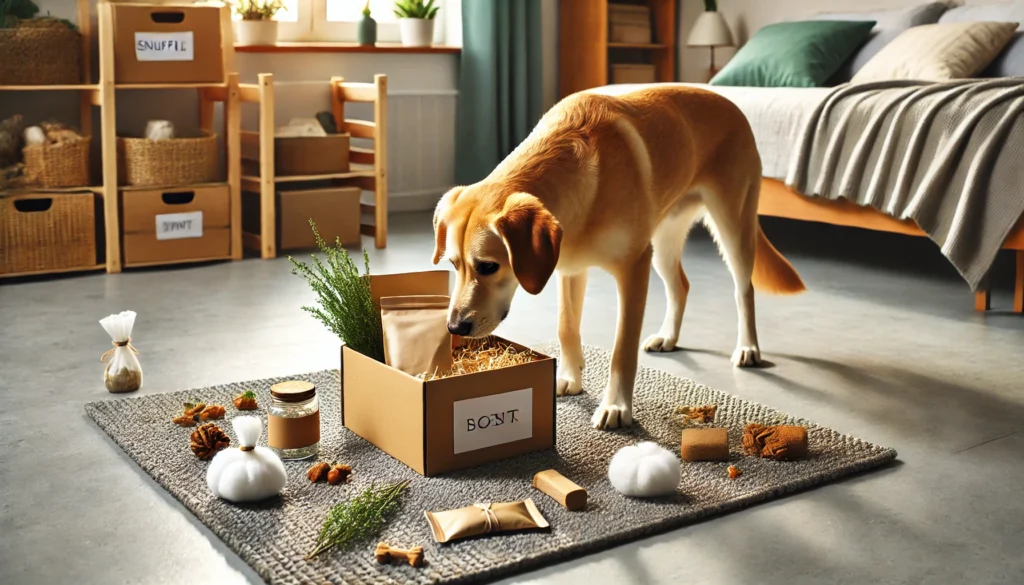For dogs, the world is a nose-first experience. While humans primarily rely on sight, dogs depend heavily on their sense of smell — which is 10,000 to 100,000 times more sensitive than ours. So when a dog is kept indoors, they may miss out on a key part of their natural sensory environment.
That’s where scent enrichment comes in. By offering safe, structured opportunities to sniff, you can reduce boredom, lower stress, and create a mentally enriching experience right inside your home.
What Is Scent Enrichment?
Scent enrichment is the use of safe and stimulating smells to engage your dog’s brain and mimic natural foraging or exploration behaviors.
It benefits dogs by:
- Activating problem-solving and focus
- Relieving stress and anxiety
- Helping reactive or nervous dogs calm down
- Reducing destructive behavior due to boredom
- Creating a richer, more interesting indoor environment
Best of all, it’s easy, low-cost, and effective for dogs of all ages and breeds.
Signs Your Dog Could Benefit From Scent Enrichment
Dogs who need more scent-based activity may:
- Sniff obsessively at doors or furniture
- Show signs of restlessness despite walks
- Destroy toys quickly or chew excessively
- Bark at minor noises or stimuli
- Pace or whine when left alone
Providing scent outlets indoors helps redirect these behaviors into something healthier and more productive.
Safe Scents Dogs Can Enjoy
Not all scents are dog-safe, so always choose carefully. Great options include:
- Herbs: basil, rosemary, mint, thyme
- Fruits (whole or peels): apple, banana, orange (in moderation)
- Green tea leaves
- Lavender (dried or low-concentration essential oil)
- Chamomile (dried, not brewed tea bags)
- Dog-safe essential oils (very diluted, vet-approved)
Avoid: eucalyptus, tea tree, clove, cinnamon, citrus oils in high concentrations, and anything synthetic or strong.
Always introduce a new scent gradually and observe your dog’s response.
DIY Scent Enrichment Activities for Indoors
Here are easy ways to introduce scent-based activities inside your home:
1. Snuffle Mat
A rubber or fabric mat where you can hide kibble or treats.
- Dogs must use their nose to find and retrieve food
- Slows down eating and encourages focus
You can buy one or make one using fleece strips tied to a rubber sink mat.
2. Scent Box
Use a cardboard box filled with:
- Crumpled paper, old towels, or toilet paper rolls
- Hide treats or toys inside for your dog to sniff out
- Rotate materials weekly for variety
Great for rainy-day play or crate-free enrichment.
3. Essential Oil Cotton Ball Game
Place one drop of diluted lavender oil on a cotton ball.
- Hide it in a sock or under a small container
- Encourage your dog to find it by scent
- Always supervise and avoid ingestion
Reward calm behavior or discovery with a treat or praise.
4. Scent Trail Game
- Drag a treat or toy along the floor in a zig-zag path
- Let your dog sniff and follow the trail to the reward
- Use rugs, furniture, or cardboard to increase challenge
Perfect for apartments or tight spaces.
5. Scent Rotation Corner
Designate a small spot in your home as the “sniff zone.”
- Place a new herb, dried flower, or scent-safe object each week
- Let your dog explore it freely
- Observe which scents calm or excite them
This passive enrichment provides daily stimulation.
When to Use Scent Enrichment
Scent activities are ideal for:
- After a walk, to promote calm focus
- Before meals, as a “hunt” exercise
- When leaving the dog home alone
- During crate time or rainy days
- As part of recovery from injury or surgery (low physical demand)
Just 10–15 minutes can have lasting effects on your dog’s behavior.
Combine Scent With Training
Scent games pair well with obedience work:
- Use scents as part of “stay,” “find it,” or “leave it” training
- Reward calm investigation with gentle praise or food
- Reinforce boundaries while encouraging curiosity
This boosts engagement and discipline at the same time.
Safety and Supervision
While scent enrichment is safe when done right, follow these guidelines:
- Never let your dog ingest scented materials
- Watch for signs of irritation or allergy (sneezing, licking, squinting)
- Store oils and herbs safely when not in use
- Don’t overwhelm your dog — use mild scents and start slow
Some dogs may be more scent-sensitive than others. Tailor activities to their preferences.
A Calmer, Happier Dog Starts With the Nose
Scent enrichment taps into your dog’s most powerful sense. Whether your dog is anxious, bored, energetic, or aging, structured sniffing can help restore balance, reduce reactivity, and provide mental satisfaction—right in the comfort of your home.
Don’t underestimate the power of a good sniff. For your dog, it’s not just fun—it’s therapeutic.






